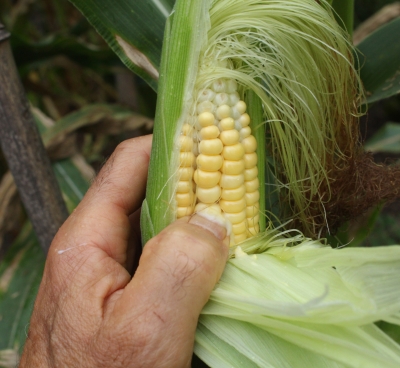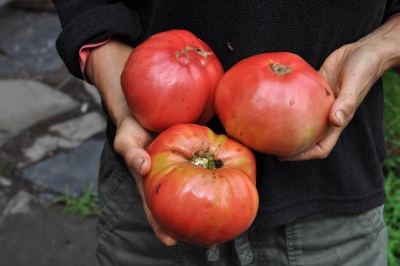Picked At Peak Of Perfection
Tomatoes Vs. Sweet Corn
Some gardeners sit tapping their fingers waiting for the first tomato of the season to finally ripen. I don’t. I’m waiting to sink my teeth into my first-picked ear of sweet corn.
Not that my tomatoes don’t taste really good, but they’re also good all winter dried or canned, as is or as sauce. Or just frozen.
An ear of sweet corn, though, captures the essence of summer. Not just for flavor and texture. It’s the whole ritual of peeling back the husks and snapping them off at their bases, brushing away the silk before steaming the ears, and then, holding an ear at each end, biting off kernels from one end to the other like an old fashioned typewriter carriage. (An image perhaps unknown to readers below a certain age.)
An art to harvesting corn at the just-ripe stage, and anxiousness for that first taste, make harvesting, especially early in the season rather tenuous. I do early planning for that first taste by counting the days-to-maturity from when I planted. Problem is that the days listed on seed packets vary: One seed company lists days to maturity for Golden Bantam, the variety I grow, at 75 days; another lists it at 85 days; another at 78 days; and yet another, more realistically, at 70 to 85 days. It depends on where the variety is grown and how the season develops.
The real countdown begins when tassels first appear atop the stalks. Harvest will be about 3 weeks hence.
Then it’s time to keep an eye out for drying tassels at the end of an ear. Once that happens, the time is near. That right moment is critical because harvested too soon, and the kernels have little taste. And this is among those fruits — yes, corn is a fruit, botanically — that will not ripen at all following harvest. Harvested too late, and the kernels are tough and starchy.
That exact right moment for harvest is when the ear feels “full” when grasped in my hand and a kernel on the peeled-back husk, with the ear still attached to the stalk, oozes a milky fluid when pressed with the thumbnail. If all these systems are go, it’s time to snap off the ear and whisk it to the waiting pot of steaming water.
Golden Bantam is a non-hybrid variety. Like other non-hybrids, a planting does not ripen all at once, which is not a good commercial characteristic. It’s fine for me, though, because between staggered plantings and a wide window for harvest for each planting, I intend to be eating Golden Bantam corn, a favorite for many gardeners since its introduction in 1906, for weeks to come.
Watermelon, Are You Ripe
Besides the first harvest of Golden Bantam, which I’ll be enjoying by the time you read this, I’m also eagerly awaiting the first harvest of watermelon, which, according to days-to-maturity listed on the seed packet, 65-75 days, I should have already been eating. (I sowed seeds indoors in pots in mid-May but it’s been a relatively cool growing season.)
While I’m confident in harvesting sweet corn at just the right moment, not so for harvesting watermelon, another fruit that will not ripen at all once harvested. Yes, I know all the published indicators of ripeness: drying up of the tendril closest where the fruit is attached to the vine; a dull thud, rather than a tighter, ringing or hollow sound, when rapped with my knuckles; and a yellow or cream-color of the fruit where it rests against the ground, and a toughening of the skin there, enough to resist indentation with a thumbnail. (The thumbnail is evidently a useful harvest tool.)

A ripe watermelon?
Still, I’m not confident about harvesting watermelons on time, and not even just the first ones to ripen. The trial and tribulation is worth it. I hope to be harvesting and eating ripe watermelon also by the time you read this. (Update: I did and it was.)
Tomatoes, You Are Ripe
In contrast to harvesting Golden Bantam corn and watermelon (I grow the variety Blacktail Mountain), tomatoes are cinch to harvest. Except for some green-ripe varieties, which I don’t grow, tomatoes turn their characteristic shade of red when ripe.
Tomatoes can even be harvested underripe to ripen off the vine. Research has shown that when a tomato is about half green and half pinkish-red on the vine, a layer of cells form across the stem of the tomato sealing it off from the main vine. Then nothing that can move from the plant into the fruit, so the fruit can ripen to perfection.
I came across some older research (J. Amer. Hort. Soc. 102:724-731. 1977) showing that the best-tasting tomatoes are those thoroughly vine-ripened. Duh. I knew that, and will harvest only vine-ripened tomatoes.





